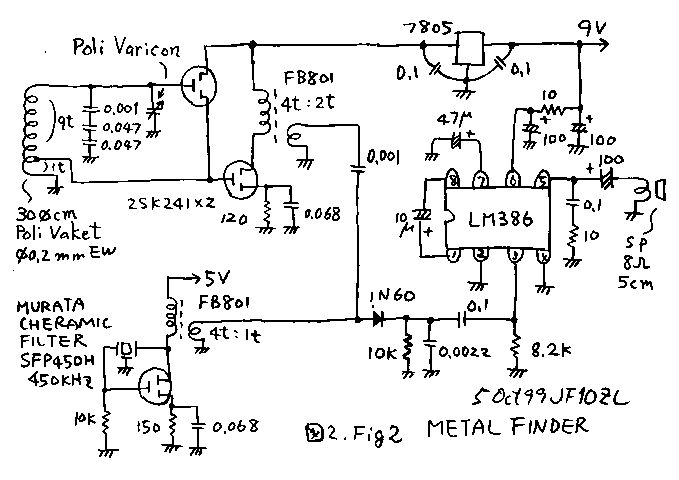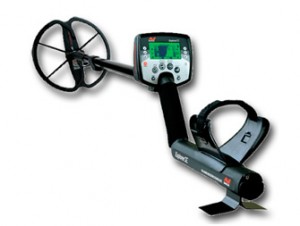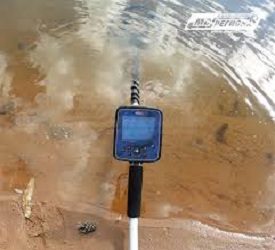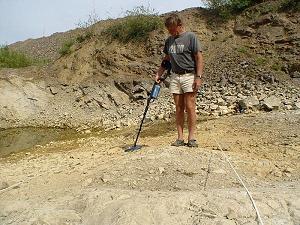How a metal detector works In the category treasure hunting more articles and learn more information about How a metal detector works Reviews Price Specifications Features Image manuals videos Accessories All this in metal detectors for gold.
How a metal detector works
If it is not necessary to know how a metal detector works to use it effectively, this may nevertheless prove useful for improving efficiency! I offer here a small presentation of the operating principle of the most common types of detectors (detector VLF), to the extent of my knowledge and that I have read, in the hope that this can help you see more clearly…
But remember that the best worldwide metal detector can never be better than the one that uses it
I – Principle of operation of a metal detector:
A metal detector works by exploiting a physical phenomenon known to all students in science (and discovered by Michael Faraday in 1831): electromagnetic induction.This phenomenon may be present as follows: any conductive object power, subject to a variation of magnetic field (variation of intensity or direction), is covered inside its volume by induced electric currents, Eddy current called. The characteristics of these currents (force and meaning) depends on the characteristics of the variation of the magnetic field and the nature of the object (form, conductivity, etc…).Eddy currents that appear within the driver object in question, generate a magnetic field radiating around the object in turn. By induction phenomenon, variations of this magnetic field may in turn induce a current flow in a conductive mass close.In a metal detector, therefore suffice to “collect” this current and analyze it to be able to identify the presence of a metal object. Let’s see how metal detectors operate this phenomenon to fill their office.
II – The V.L.F. detectors (Very Low Frequency: very low frequency)
Under this name, we’ll talk about the detectors very low frequency (< 30 kHz) and low frequency (between 30 kHz and 300 kHz).
This type of detector is by far the most common (and least expensive). Actually 95% of the market devices belong.
In the sensor head (disk) are two spools of thread:
(1) The transmitter coil:
This reel, crossed by a sinusoidal alternating electric current (reverse thousands of times per second), generates a magnetic field (whose polarization is reversed at the same frequency as that of the current) around it. The frequency at which this inversion is performed is none other than the operating frequency of your device you are talking about the advertising (operating frequency). We will call this frequency ‘F’.
curve of the current flowing through the transmitter coil.
When a metallic object enters the magnetic field changing polarity (reverse polarity 1/F times per second), eddy currents appear in its midst. These currents generate a magnetic field fluctuating, which tends to compensate the magnetic field generated by the transmitter coil in turn.
(2) The receiving coil: an other wire coil in the sensor head is going to react to the magnetic field emitted by our metal object (this reel is arranged in such a way that the current that should induce the magnetic field of the transmitter is almost canceled).
A current induced appears then at its terminals. This current, amplified and processed by the electronics of the detector to provide the prospector of information (sounds, vu-meter, digital display, etc.), the presence of a metal object under the sensor head. The signal received through the takeup spool appears delayed with respect to the signal emitted by the transmitter coil. This delay is the result of two characteristics that possess all conductive materials:-resistance (a trend that has the driver to oppose the flow of current in its breast)
-Inductance (a trend that has the driver to oppose the flow of current in its breast changes)
This period is called the “phase shift”. The largest phase shifts are observed for metallic objects which the inductance is the best: the large, thick objects made of very good conductive metals (such as silver, gold or copper). Lower phase shifts appear to primarily “resistant” objects: the objects smaller, finer or less good drivers.
A non-contractual example of a lag phase between transmitted and received signal
How a metal detector works
Some “materials”, bad, or very bad drivers are likely to generate a strong signal. These are the “ferro-magnetic”. A ferro-magnetic substance will tend to become magnetized when it is immersed in a magnetic field (kinda like a paperclip turns momentarily magnet when it is put in contact with a magnet). The phase offset generated by these objects is very low, or non-existent.Most of the land and Sands contain small grains of minerals (referred to as the mineralization of the soil). These grains have a ferro-magnetic behavior important to the detector.
The zippers and other steel capsules have both ferromagnetic and electrical properties.
(3) The discrimination:
Since for each type of metal and object, the signal received by the take-up reel shows a particular phase offset from the signal, it is possible to differentiate between one metal to another, just by analyzing their respective phase shifts. For example, a silver coin will have a phase offset significantly higher than that of a zipper in alu.
Based on this principle, a sensor may be designed to do sound on the silver coin and ignore the zipper. This ability to distinguish the metal targets compared to the other one is called the ‘discrimination’.
Classical discrimination:
The simplest form of discrimination is to allow the metal detector to play a sound when it passes over a target which the phase shift exceeds a certain value (often adjustable by potentiometer). Unfortunately, with this type discriminator, the detector may lose small objects in gold (among others) or even parts, if the discrimination is set high enough to reject the aluminium (foil, zippers, capsules, etc…).
Notch Discrimination:
A more efficient system is to accept (or reject for the most sophisticated devices) that a certain range of phase shift. It is the Notch discrimination. With this system, you can for example accept the band corresponding to the alliances in gold and reject everything else (in theory). You can also (with the best designed aircraft), reject the band corresponding to the aluminum zippers without taking the risk of losing what lies beneath (in terms of phase shift).
Visual discrimination:
Some metal detectors to get via a vu meter or an LCD display, information about the identity of the target. This system of Visual discrimination, sound discrimination, gives the prospector’s additional information allowing better make his choice between dig or not.
Some metal detectors can “identify” an object based on a table of inductance on resistance reports. These reports predict a phase shift for a type of object at a given frequency. Using fixed or variable frequencies, the sensor is capable, depending on the reaction of the object detected at each of these frequencies, to predict its ‘identity’.
The difficulty of discrimination lies in the fact that an object with a phase shift at a certain depth and with a certain orientation (flat for one piece, for example), can have a dramatically different phase shift at a different depth and with a different orientation (exhibit on the instalment in our example). In addition, the shape of the object is also much! Electromagnetic induction is strong enough for a circular object (ring for example), where the current circulates in closed circuit. When the object is “open” (e.g. metal rod), induction is much lower.
Alliance Gold, for example, it may produce very different results, depending on whether the ring will be intact or broken.
In all cases, the discrimination must be used with caution. If it is of some help in many situations, it is never safe to 100%. Even with a Notch system, when for example you reject the band corresponding to the alu zippers, you still have a non-negligible risk of also losing a gold jewel which, according to its form, its position and its depth in the soil, will be interpreted as belonging to the rejected Strip.
(4) Compensation for the effects of soil:
How a metal detector works
As seen previously, most of the sand and land contain a certain amount of minerals dissolved in the water contained in the soil, as well as particles of iron or other metals. This has the effect that the detector receives a signal due to the soil itself, which sometimes can be very superior in strength the signal to a small metal object at medium depth.
Fortunately, the phase shift of the signal due to the effects of soil remains almost constant on a area of given field. With electronic processing on this phase shift, it is possible in the detector to undo the effects of this signal, even if it changes in intensity (when raises or lowers the head of detection for example or it passes on a hole or a bump).
The simplest form of compensation of ground effect consists of a potentiometer is adjusted by raising and lowering the sensor head in having put its detector to the correct mode. Although this method is effective, it can seem daunting and difficult in the eyes of most people.
More sophisticated detectors will allow automatic adjustment of compensation of the effects of soil. Only two tune-ups are needed: a thrown head and another head down.
In still more sophisticated models, the setting will be automatically as prospecting, thus taking into account changes in the ground ground effect.
A good system of compensation of ground effect is supposed be set once for all at the beginning of meeting and thus run all day without needing to touch (for a given soil).
Caution: certain sensors, windy in pubs as having an effect of automatic soil compensation, have in fact a mode “preset”: fixed compensation, set at the factory and sensible value be adapted to most of the land.
(5) Mode scan (motion):
Although the signal due to ground effect can be much more intense than a target signal, it remains relatively constant while the head on the ground. On the other hand, the power of the signal from a target will grow very rapidly when the head passes over the object and decrease when the head depart.By using this phenomenon, we are able to separate the signals of ground from those of a target, by analyzing the rate of change of the signal, rather than signal itself. The modus operandi of the detectors of metals operating on this principle is called “Scan Mode” (Motion mode), because of course they cannot indicate a target only if the head scans the ground.This explains that some sensors give very different results depending on the speed at which you scan the ground! Fortunately today, many models, more stable, overcome this inconvenience and work just as well with a slow scan with a quick scan.
At the present time, all detectors using discrimination do so in scan mode. This is not really a drawback, because anyway, to cover the ground, we must carry out sweeps!
(6) Static mode (non-motion), Pinpoint and threshold:
How a metal detector works
Once the target is localized in scan mode, it is preferable to locate it specifically that constantly sweeping the ground! This precise location (Pinpoint) is done with the mode “all metals”. As by definition, discrimination is not required for this function, scanning is unnecessary, except for the best Center the head on the target (and then the scanning speed is absolutely unimportant). This is why the mode “all metals” is also called “static mode” (non-motion). Associated with the static mode and the pinpoint, is the setting of threshold (Threshold adjust). This setting is often materialized on the detector by a push button (sometimes labeled “pinpoint”, since it is directly associated to it). This setting allows to threshold (signal level from which the detector sounds), the level picked up at the point where the button is pressed. Wholesale, the detector is set for removing the signal received the value of the signal when the button is pressed.This will result in eliminating the component ‘ground effect’ signal (at a given distance from the floor) and so did hear the target when on top (always at the same distance). Will ring the sensor and if it lowers the sensor head, the signal due to ground effect will increase. It will take then again press the button to adjust the threshold by decreasing.Ditto if it throws the head of detection to the level of the target: the detector will pick up a signal whose power will be below the threshold. It will more sound. Therefore, press the button again to increase the threshold accordingly.On some model, the adjustment of the threshold is done automatically. The threshold is then increased and decreased gradually to get sound light in threshold limit. The advantage of this system is that it allows to compensate for small variations in ground effect, as well as an incorrect setting of compensation. The major drawback is that it requires a scan to run. This is why you will hear of sensors having a ‘real static mode’ (True Non-Motion mode) “, devoid of automatic adjustment of threshold.”
Another source of confusion is that some sensors allow adjustment of discrimination on a position 0, which pass all metals. The mode of operation remaining discrimination (scan mode), cannot talk mode “all metals”. You hear so often “0 Disc” mode.
(7) Control by microprocessor:
I wouldn’t have the affront to the insiders to give in detail the definition of the microprocessor. In short, one could say that the microprocessor is a complex electronic integrated circuit which allows to execute logical, arithmetic operations and control with a computer needs to operate. It is the heart, or rather the brain of a computer. It is capable of performing sequences of elementary instructions called “programs” at high speed (several million instructions per second).The use of microprocessors in the metal detectors to open opportunities unimaginable only a few years back! With the microprocessor, all (or almost) the settings are made through a single screen LCD and keyboard handling. A menu system allows from a main menu to access all the parameters of the machine and change according to the needs (each configuration parameters can be independently save in memory, allowing you to be able to recall at all times if necessary is, without having to fix everything again).On a ‘classic’ detector, add new features mean: add new electronic circuits, new buttons, sliders, etc… With the microprocessor, add a function can be summarized to modify the internal program of the machine (without addition of circuit). And fort is betting that one day (close?), can update a detector such as the Spectrum system, simply by connecting it to your PC and getting the update on the Internet! Manufacturers…This may seem a bit complicated, but if you do not want clutter you of settings and complex manipulations, you can still use settings preset at the factory. Such program will give you a survey without capsule alu, another will be optimized for the detection of parts, etc…A very interesting advantage is also that microprocessor capabilities can be used to greatly improve the analysis of the signal in sound discrimination. And nothing keeps take advantage of this power to refine the sound rendering (modulation in amplitude and height, potentially very fine).The LCD display also allows much improvement, as for example the Visual signal analysis using bar-graph or response curves, making the job much simpler interpretation for the prospector.
Attention however, the microprocessor is not a miracle tool! For example, if you reject the aluminium foil and a small chain or comes to a close signal of the paper said, you will the lose as well as with a conventional detector! In addition, these devices require experience to really good use and get the most!
(8) Conclusion:
VLF detectors have decades of existence behind them, new innovations will continue to emerge. Machines more efficient, more powerful, easier to use, are brought to appear. As long as there is some prospectors and “juicy” markets (United States, Australia, England, etc.) and there will be things to find, very is bet that the research will continue to provide our future detectors!
How a metal detector works
- CTX 3030 standard gold detector
- XP metal detectors – XP DEUS Metal detector Reviews
- A GPR x-3 2012
- Picture Atlantic archaeological discovery in Fayoum in Egypt 42 million years old
- Metal detector Bounty Hunter Discovery 1100
- Operation Metal Detector Tracker – PI
- fisher f2 pro metal detector
- Metal detector GARRETT MAGNASCANNER MS -3500
- أجهزة الكشف عن المعادن للمساعدة في الأمن الشرطة والمطار
- Titan Metal Detector Gold Silver Nuggets















